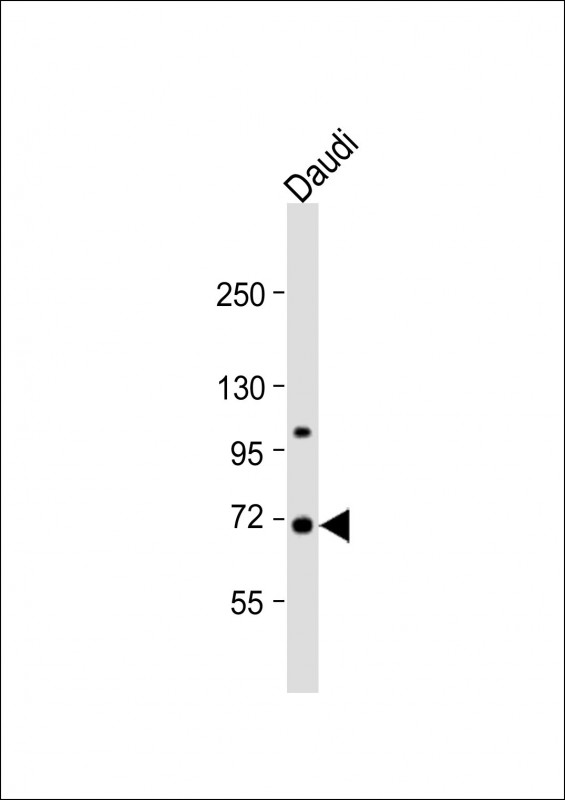SIGLEC10 Antibody (C-term)
Affinity Purified Rabbit Polyclonal Antibody (Pab)
- 产品详情
- 实验流程
- 背景知识
Application
| WB, E |
|---|---|
| Primary Accession | Q96LC7 |
| Reactivity | Human |
| Host | Rabbit |
| Clonality | Polyclonal |
| Isotype | Rabbit IgG |
| Calculated MW | 76592 Da |
| Antigen Region | 656-687 aa |
| Gene ID | 89790 |
|---|---|
| Other Names | Sialic acid-binding Ig-like lectin 10, Siglec-10, Siglec-like protein 2, SIGLEC10, SLG2 |
| Target/Specificity | This SIGLEC10 antibody is generated from rabbits immunized with a KLH conjugated synthetic peptide between 656-687 amino acids from the C-terminal region of human SIGLEC10. |
| Dilution | WB~~1:1000 E~~Use at an assay dependent concentration. |
| Format | Purified polyclonal antibody supplied in PBS with 0.09% (W/V) sodium azide. This antibody is purified through a protein A column, followed by peptide affinity purification. |
| Storage | Maintain refrigerated at 2-8°C for up to 2 weeks. For long term storage store at -20°C in small aliquots to prevent freeze-thaw cycles. |
| Precautions | SIGLEC10 Antibody (C-term) is for research use only and not for use in diagnostic or therapeutic procedures. |
| Name | SIGLEC10 |
|---|---|
| Synonyms | SLG2 |
| Function | Putative adhesion molecule that mediates sialic-acid dependent binding to cells. Preferentially binds to alpha-2,3- or alpha-2,6-linked sialic acid (By similarity). The sialic acid recognition site may be masked by cis interactions with sialic acids on the same cell surface. In the immune response, seems to act as an inhibitory receptor upon ligand induced tyrosine phosphorylation by recruiting cytoplasmic phosphatase(s) via their SH2 domain(s) that block signal transduction through dephosphorylation of signaling molecules (PubMed:11284738, PubMed:12163025). Involved in negative regulation of B-cell antigen receptor signaling. The inhibition of B cell activation is dependent on PTPN6/SHP-1 (By similarity). In association with CD24 may be involved in the selective suppression of the immune response to danger-associated molecular patterns (DAMPs) such as HMGB1, HSP70 and HSP90 (By similarity). In association with CD24 may regulate the immune repsonse of natural killer (NK) cells (PubMed:25450598). Plays a role in the control of autoimmunity (By similarity). During initiation of adaptive immune responses by CD8- alpha(+) dendritic cells inhibits cross-presentation by impairing the formation of MHC class I-peptide complexes. The function seems to implicate recruitment of PTPN6/SHP-1, which dephosphorylates NCF1 of the NADPH oxidase complex consequently promoting phagosomal acidification (By similarity). |
| Cellular Location | [Isoform 1]: Cell membrane; Single-pass type I membrane protein [Isoform 3]: Cell membrane; Single-pass type I membrane protein [Isoform 5]: Secreted. |
| Tissue Location | Expressed by peripheral blood leukocytes (eosinophils, monocytes and a natural killer cell subpopulation) Isoform 5 is found to be the most abundant isoform. Found in lymph node, lung, ovary and appendix. Isoform 1 is found at high levels and isoform 2 at lower levels in bone marrow, spleen and spinal cord Isoform 2 is also found in brain. Isoform 4 is specifically found in natural killer cells. |
For Research Use Only. Not For Use In Diagnostic Procedures.
Provided below are standard protocols that you may find useful for product applications.
BACKGROUND
SIGLEC10 is a putative adhesion molecule that mediates sialic-acid dependent binding to cells. It preferentially binds to alpha2,3- or 2,6-linked sialic acid. The sialic acid recognition site may be masked by cis interactions with sialic acids on the same cell surface. In the immune response, may act as an inhibitory receptor upon ligand induced tyrosine phosphorylation by recruiting cytoplasmic phosphatase(s) via their SH2 domain(s) that block signal transduction through dephosphorylation of signaling molecules. SIGLEC10 interacts with PTPN6/SHP-1 upon phosphorylation. The protein is expressed by peripheral blood leukocytes (eosinophils, monocytes and a natural killer cell subpopulation). Isoform 5 is found to be the most abundant isoform, found in lymph node, lung, ovary and appendix. Isoform 1 is found at high levels and isoform 2 at lower levels in bone marrow, spleen and spinal chord. Isoform 2 is also found in brain. Isoform 4 is specifically found in natural killer cells. SIGLEC10 contains 1 copy of a cytoplasmic motif that is referred to as the immunoreceptor tyrosine-based inhibitor motif (ITIM). This motif is involved in downmodulation of cellular responses. The phosphorylated ITIM motif binds to the SH2 domain of PTPN6/SHP-1. Phosphorylation of Tyr-667 is involved in binding to PTPN6. The SIGLEC10 gene belongs to the immunoglobulin superfamily.
REFERENCES
Strausberg, R.L., et al., Proc. Natl. Acad. Sci. U.S.A. 99(26):16899-16903 (2002).
Kitzig, F., et al., Biochem. Biophys. Res. Commun. 296(2):355-362 (2002).
Li, N., et al., J. Biol. Chem. 276(30):28106-28112 (2001).
Yousef, G.M., et al., Biochem. Biophys. Res. Commun. 284(4):900-910 (2001).
Munday, J., et al., Biochem. J. 355 (Pt 2), 489-497 (2001).
终于等到您。ABCEPTA(百远生物)抗体产品。
点击下方“我要评价 ”按钮提交您的反馈信息,您的反馈和评价是我们最宝贵的财富之一,
我们将在1-3个工作日内处理您的反馈信息。
如有疑问,联系:0512-88856768 tech-china@abcepta.com.























 癌症的基本特征包括细胞增殖、血管生成、迁移、凋亡逃避机制和细胞永生等。找到癌症发生过程中这些通路的关键标记物和对应的抗体用于检测至关重要。
癌症的基本特征包括细胞增殖、血管生成、迁移、凋亡逃避机制和细胞永生等。找到癌症发生过程中这些通路的关键标记物和对应的抗体用于检测至关重要。 为您推荐一个泛素化位点预测神器——泛素化分析工具,可以为您的蛋白的泛素化位点作出预测和评分。
为您推荐一个泛素化位点预测神器——泛素化分析工具,可以为您的蛋白的泛素化位点作出预测和评分。 细胞自噬受体图形绘图工具为你的蛋白的细胞受体结合位点作出预测和评分,识别结合到自噬通路中的蛋白是非常重要的,便于让我们理解自噬在正常生理、病理过程中的作用,如发育、细胞分化、神经退化性疾病、压力条件下、感染和癌症。
细胞自噬受体图形绘图工具为你的蛋白的细胞受体结合位点作出预测和评分,识别结合到自噬通路中的蛋白是非常重要的,便于让我们理解自噬在正常生理、病理过程中的作用,如发育、细胞分化、神经退化性疾病、压力条件下、感染和癌症。






